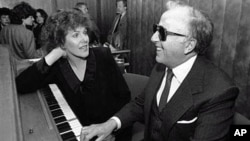Famed jazz pianist and composer George Shearing, 91, died Monday, February 14 of heart failure in New York City. Shearing was born in England but settled in the United States in 1947. His recording career lasted more than six decades and included albums with some of the top names in jazz. Despite being blind, George Shearing became one of the world's most popular performers.
George Shearing appeared on the American jazz scene in the early 1940s with a series of successful recordings that featured a fine-tuned rhythm section of guitar, bass, drums and vibraphone. He was already quite famous in England, but after the release of his hit song "September In The Rain," his quintet rose to new heights.
Shearing was born blind in London on August 13, 1919. He began playing piano at age three and soon fell in love with the music of Earl Hines, Fats Waller, and Art Tatum. At 19, he performed jazz accordion in Claude Bampton's all-blind band and got his first real taste of show business.
"One night, we were all ready to go. Fifteen blind musicians taught to play instruments from being chair caners and basket makers and so on," Shearing said. "Now, we're all ready to go in the theatre and the stage manager says 'Ok fellas.' And someone's glass eye had fallen out, rolled across the stage, [and] fifteen blind guys [are] down on the floor looking for this eye. They found it and gave it to him, and he put it in and the show got underway."
Shearing won over American audiences with his own style of boogie-woogie, blues and jazz swing which later became known as "The Shearing Sound." One of his best-known compositions is the jazz standard “Lullaby of Broadway,” co-written with lyricist George David Weiss.
Critics were enamored of his heartfelt melodies often described as "romantic" and "whimsical." Shearing once said the birth of rock 'n' roll gave a new dimension to his repertoire.
"We have benefited from the embryonic stages of rock and roll which started probably in the early '50's, and are now the glad recipients, most of the time, of a healthy integration between jazz, folk and rock," he said.
Over the years, Shearing's ever-changing personnel included singers Mel Torme, Carmen McRae and Peggy Lee, as well as Joe Pass, Cal Tjader and Hank Jones. His 1962 album "Nat 'King Cole' Sings, George Shearing Plays" features one of the most famous piano introductions of all time on the selection "Let There Be Love." In 1976, he collaborated with the great French jazz violinist Stephane Grappelli for the critically-acclaimed album "Reunion." In 2003, he received a Lifetime Achievement Award from the BBC Jazz Awards.
Shearing avoided the trappings of jazz fusion, synthesizers and electronics that arrived late in his career. He believed that more volume didn't necessarily mean better music.
"I know that there is quite a bit of talent around and it's too loud," Shearing said. "And it's a shame."
At the peak of his career, George Shearing was immortalized in Jack Kerouac's 1957 novel “On The Road.” Upon seeing Shearing in a Chicago nightclub, Kerouac wrote, "as always he leaned his blind head on his pale hand, all ears opened like the ears of an elephant, listening to the American sounds and mastering them for his own English summer-night's use."








